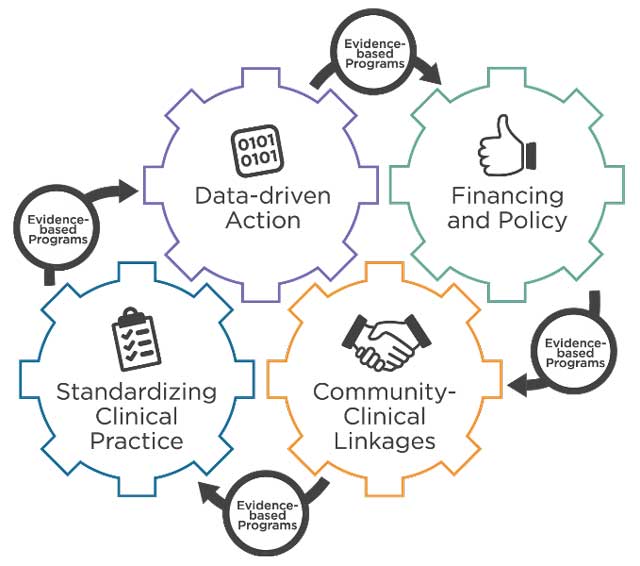Engaging Communities and Healthcare Partners to Improve Heart Health: Progress and Opportunities for Public Health
February 15, 2018 | Marcus Plescia
It seems fitting for Valentine’s Day to occur during American Heart Month, a national health observance that reminds Americans to focus on their hearts. Promoting heart health is an important duty for public health leaders, too. Cardiovascular disease is the most common cause of death in this country and a source of considerable suffering and disability. It’s also one of our success stories: Public health has made significant progress in reducing deaths from cardiovascular disease, mostly through tobacco control efforts and medical advances. However, following years of decline, these deaths rates are leveling off and additional action is needed to sustain progress and save countless lives—not just in February, but all year round.
Tobacco use and obesity are significant behavioral risk factors for cardiovascular disease. Systemic approaches to discourage youth smoking and change the food and physical environment have been highly effective interventions. However, controlling high blood pressure, identifying elevated cholesterol, and supporting smoking cessation are also important approaches with lasting implications for public health. Late last year, the American College of Cardiology and the American Heart Association released new blood pressure guidelines that lower the optimal blood pressure target from below 140/90 to below 130/80. Among individuals with high blood pressure, only half were in compliance with the previous guidelines; even fewer will meet the new targets.
In 2012, CDC and CMS launched the Million Hearts initiative, with the goal of preventing one million heart attacks and strokes over five years in the United States. The initiative convened local, state, and national partners across the nation to lower rates of heart disease using the ABCS:
- Aspirin when appropriate
- Blood pressure control
- Cholesterol management
- Smoking cessation
Experts say the initiative may have prevented up to half a million cardiovascular disease events from 2012 through 2016.
CDC recently set new goals and strategies for Million Hearts for 2022 and these priorities will be highlighted during CDC’s Grand Rounds on Feb. 20. The event will also feature the Tennessee Department of Health’s prevention-focused multidisciplinary work to build healthy communities.
State and territorial public health departments have been closely involved in both Million Hearts and other efforts to improve blood pressure control. ASTHO received funding from CDC to work with states to implement and support improvements in blood pressure control by working with clinical practices and healthcare systems. The ASTHO Heart Disease and Stroke Prevention Learning Collaborative has focused on data-driven action, standardizing clinical practice, community-clinical linkages, and financing and policy.

Over the last five years, 26 states, the District of Columbia, and the Republic of Palau have engaged nearly 300 state and local partners across the country, developed and implemented more than 100 data exchange, referral, and follow-up protocols, identified nearly 27,500 individuals at risk for hypertension, and supported nearly 15,000 individuals in controlling their blood pressure.
While much of the collaborative’s initial focus has been on optimizing clinical care, effective blood pressure control also requires community-based interventions and support. Recognizing this important linkage, ASTHO is now leveraging additional CDC funds to help support collaboration between state and local health departments, community health centers, and local YMCAs to support community-based interventions. The project emphasizes self-measured blood pressure monitoring, an evidence-based approach that requires significant community partnerships and systems change interventions. In the last four years, at least three state health departments have been engaged in this project through collaboration with health center-controlled networks and third-party payors, serving as conveners between local health departments and health centers.
As with many aspects of public health, factors contributing to cardiovascular disease are community-wide and require work outside of traditional public health activities. Clinically-driven interventions to improve systems of care and reward quality care outcomes have had significant and timely impact. However, motivation and support for ongoing control of high blood pressure and other cardiovascular risk factors will ultimately require more emphasis on identifying and developing community resources. The emerging role for public health is to enhance coordination between healthcare providers and community-based organizations to address interconnected social, cultural, and health literacy issues that influence how individuals manage their chronic medical conditions.